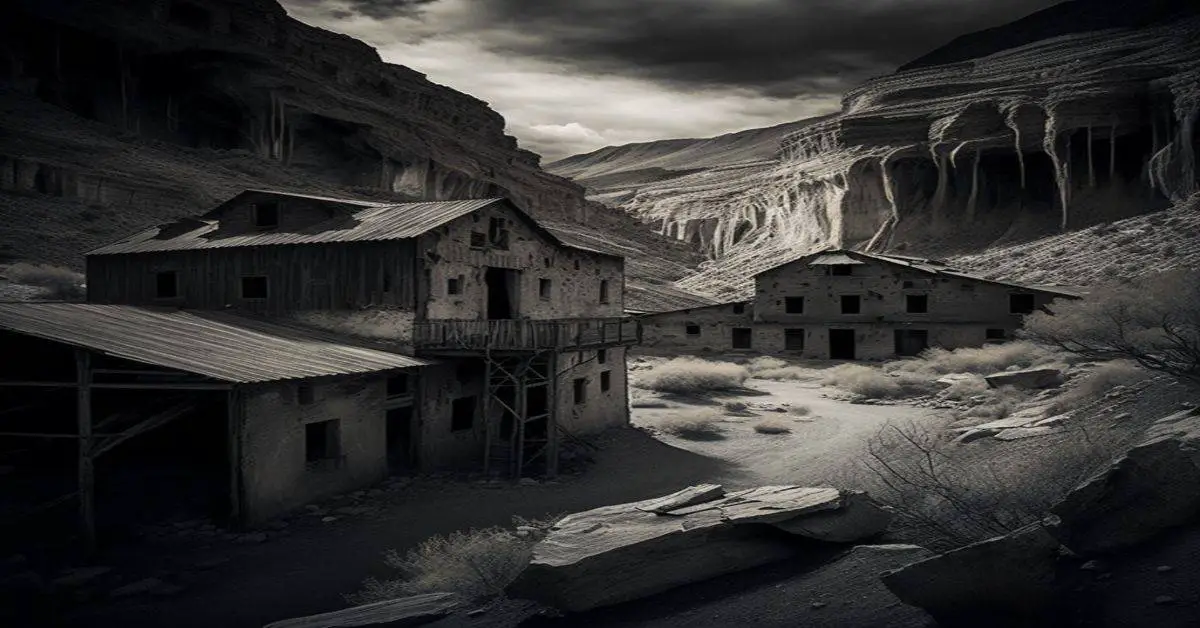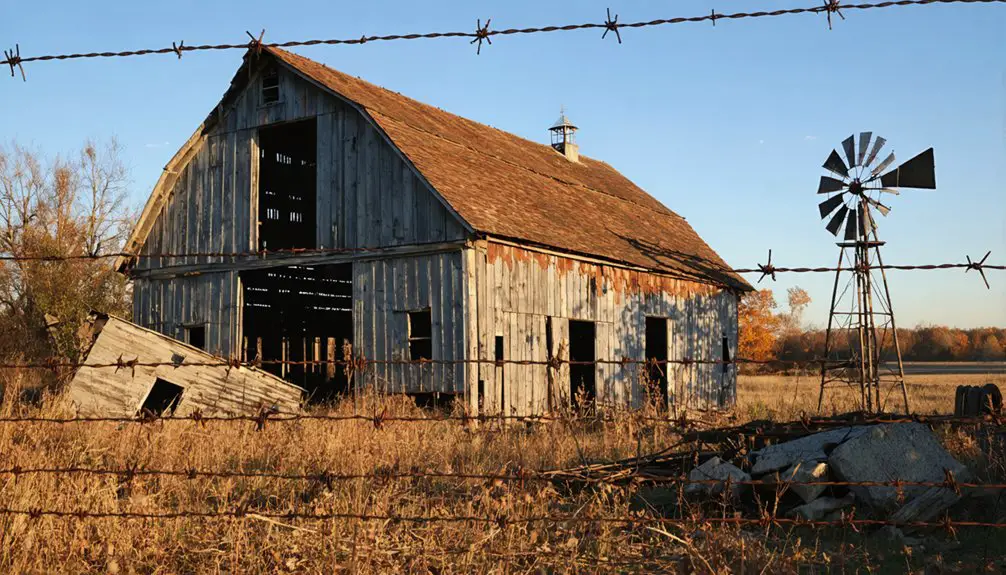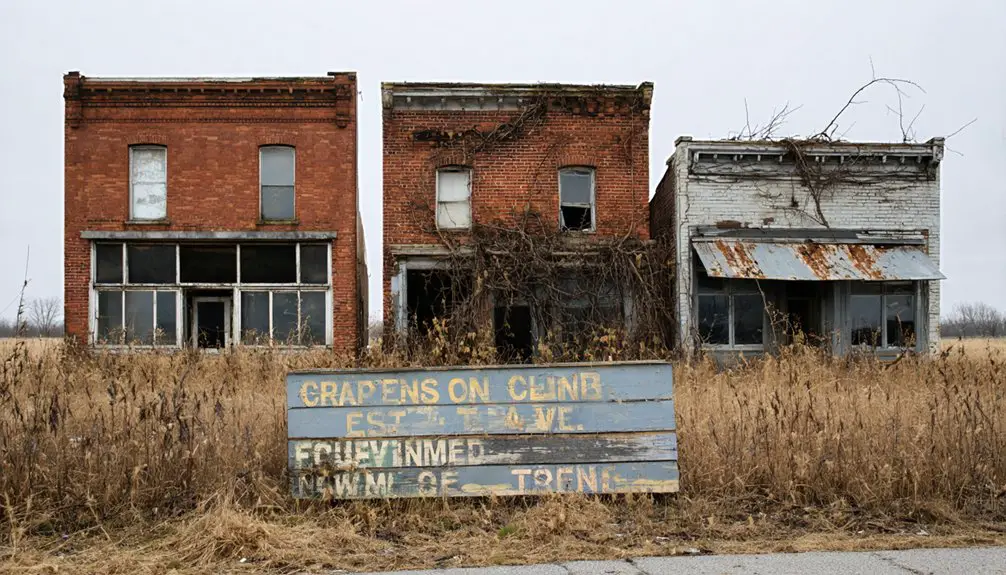You’ll find Rural Hill, Ohio‘s remains scattered among stone foundations and cellar holes, marking where a once-bustling 19th-century community thrived around the Farris and Company Slaughterhouse. The Syrian immigrant-founded operation served as the town’s economic backbone until its closure, which triggered widespread abandonment. While most wooden structures have decayed, the site’s ruins, documented by historians and archaeologists, tell a compelling story of boom-and-bust economics in the Ohio Valley region.
Key Takeaways
- Rural Hill transformed from a thriving industrial town to a ghost town after its main employer, the Farris and Company Slaughterhouse, closed.
- The town’s economic foundation centered around slaughterhouse operations and a grist mill during the 19th century.
- Only scattered stone foundations, cellar remnants, and slaughterhouse ruins remain as evidence of the once-bustling community.
- Syrian immigrants established the multi-generational Farris and Company Slaughterhouse, which shaped the town’s social and economic structure.
- Geographic isolation, lack of economic diversification, and population exodus following industrial closure led to Rural Hill’s abandonment.
The Rise and Fall of Rural Hill
While many Ohio ghost towns faded into obscurity gradually, Rural Hill’s dramatic change from thriving community to abandonment hinged primarily on its slaughterhouse operations.
You’ll find the town’s economic resilience was initially strong, with the slaughterhouse providing steady employment and attracting related businesses to support workers’ families.
The community identity centered around this industrial hub, with residential areas and local commerce flourishing in the 19th century.
You’d have seen a typical rural Ohio settlement, complete with mills and small industries contributing to the local economy.
Similar to the forced evacuations in Boston Township, residents had no choice but to leave their homes behind.
Like the haunted Bellaire House above a cursed coal mine, many abandoned buildings took on an eerie atmosphere.
However, when the slaughterhouse closed, Rural Hill’s fate was sealed.
Without its primary employer, the town couldn’t sustain itself.
Workers left, businesses shuttered, and buildings fell into disrepair, marking Rural Hill’s shift to ghost town status.
Life Around the Slaughterhouse
If you’d visited Rural Hill’s slaughterhouse during its heyday, you’d have witnessed the early morning arrival of workers – both free and enslaved – as they prepared for the day’s processing tasks alongside local farming families who managed operations.
The facility’s daily routines revolved around seasonal livestock deliveries, with skilled butchers and laborers working in gender-specific roles to process animals while maximizing the use of every part. Local farmers would often bring their Merino sheep for processing, following the successful breeding practices established by Thomas Rotch. The operation grew substantially after A.B. Davidson installed a large grist mill to support local agricultural needs.
The slaughterhouse served as more than just a processing plant – it was a community hub where farmers gathered to exchange news and conduct business, creating a social fabric that defined Rural Hill’s character.
Daily Worker Routines
Because slaughterhouse work demanded precise timing and coordination, workers followed strict daily routines that began well before sunrise. You’d arrive while the town still slept, donning protective gear and checking equipment before the first livestock deliveries rolled in on the nearby railroad tracks. The four-story structure required workers to navigate multiple levels throughout their shifts.
Worker schedules revolved around specialized roles – you might inspect arriving animals, operate cutting machinery, or prepare shipments for market. Task efficiency meant you’d have minimal breaks during your shift, with strictly timed meals between the constant flow of production. Just as the Medal of Honor recipients exemplified dedication during battle, workers maintained unwavering discipline in their duties.
You’d work shoulder-to-shoulder with fellow employees, often family members or neighbors from your ethnic community, developing precise movements that became second nature. The physical demands and exposure to harsh conditions required unwavering focus as you navigated the facility’s complex network of processing floors.
Family Business Ties
Since establishing Farris and Company Slaughterhouse in 1921, Syrian immigrants Najeeb and Eva Farris created more than just a business – they built a multi-generational enterprise that would shape Rural Hill’s economic and social fabric for decades.
You’d find family legacy deeply woven into every aspect of operations, from living quarters near the premises to key decision-making remaining within the family circle.
The economic ties extended beyond direct employment, as local families relied on the slaughterhouse for various income streams – from butchering to maintenance, logistics, and cleaning.
Like many in agriculture, they carefully chose euphemistic language terms to describe their work processes to avoid potential controversy or criticism from outsiders.
Family members worked side by side, with roles often divided by gender: men typically handled butchering while women managed product preparation and cleaning.
This arrangement fostered tight-knit community bonds, where shared work experiences reinforced cultural traditions and created lasting support networks.
Community Around Processing Plant
While the Farris slaughterhouse dominated Rural Hill’s economic landscape, it also shaped the social fabric of daily life around the processing plant.
You’d find the community ties woven through a network of workers, suppliers, and local markets, all interconnected by the daily rhythms of meat processing operations.
The plant’s economic impact extended beyond just employment. Modern facilities employed thousands of workers across all aspects of meat processing and distribution.
You’d see butchers passing down their traditional craft knowledge to the next generation, while farmers regularly brought their livestock to market.
The facility’s strategic location created a hub where rural and urban economies merged, with trucks distributing products to stores and restaurants throughout the region.
Plant workers weren’t just employees – they were integral members of a community that depended on the slaughterhouse for both their livelihoods and their daily sustenance.
Union stewards played vital roles in representing worker interests and maintaining labor relations at the facility.
Legacy of a Lost Community
After the closure of its main slaughterhouse employer, Rural Hill’s legacy evolved from a thriving industrial community into a reflection of economic vulnerability in rural Ohio.
You’ll find its story echoing in local historical societies, where cultural nostalgia preserves memories of daily life and labor through oral traditions.
The town’s transformation from bustling community to ghost town serves as a stark reminder of the fragility of single-industry economies. Like the Moonville Rail Trail, efforts to preserve and connect these abandoned communities help maintain their historical significance.
When a town stakes its survival on a single industry, its fate becomes inextricably linked to that industry’s success or failure.
- The abandoned buildings and foundations reveal the community’s former layout and economic foundation
- Local cemeteries and ruins now serve as physical connections to the past
- Environmental changes have reclaimed much of the original town site
- Stories of hauntings and folklore keep the town’s memory alive through paranormal tourism
What Remains Today
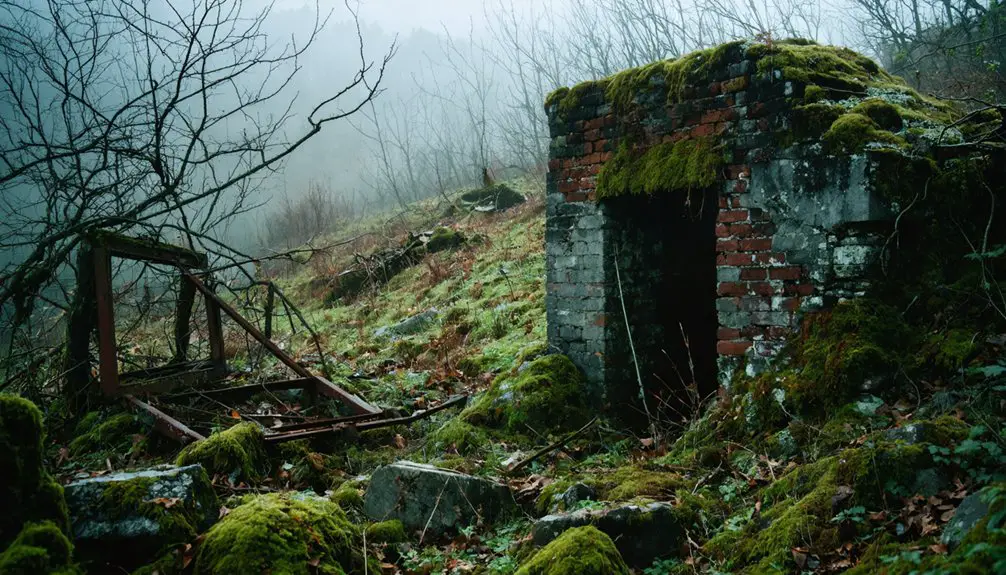
If you visit Rural Hill today, you’ll find scattered stone foundations and cellar remnants as the primary physical evidence of the once-thriving mining community.
Local historians and archaeologists continue mapping and documenting these structural ruins, collecting artifacts like pottery shards and mining tools that surface over time.
Interpretive signs and occasional guided tours help visitors identify key historical features, though most of the original wooden buildings have long since succumbed to natural decay.
Physical Structure Ruins
Today’s visitors to Rural Hill, Ohio encounter a landscape dominated by the decaying remnants of its past, with stone and brick foundations marking where homes and businesses once stood.
You’ll find the most substantial ruin preservation at the old slaughterhouse site, where concrete slabs and rusted machinery tell the story of the town’s industrial heart. Natural forces continue driving structural decay, as vegetation breaks through the remaining stone walls and weathering erodes what’s left.
- Dense undergrowth now conceals building footprints, visible only as subtle ground patterns
- Metal fixtures and scattered nails rust among the rubble of fallen structures
- Bridge abutments and culverts mark forgotten transportation routes
- Former rail beds reveal themselves through occasional ties and rails emerging from the soil
Historic Site Documentation
Despite its historical significance as a bustling industrial town, Rural Hill now exists primarily through scattered documentation and minimal physical remnants.
You’ll find most historic records focusing on the town’s economic lifeline – its slaughterhouse – and the subsequent decline that led to abandonment.
While county archives may house archival photographs and maps from the town’s active years, there’s no thorough preservation of these materials.
You won’t discover any formal historic markers or dedicated museum exhibitions about Rural Hill.
The town’s documentation largely consists of basic census data, postal records, and occasional mentions in Ohio ghost town listings.
Local historical societies maintain some records, but they’re often fragmented and incomplete, reflecting the broader pattern of how many small, industrial-dependent Ohio towns fade from memory.
Tracing the Town’s Economic Decline
While Rural Hill once thrived as an industrial hub centered on iron smelting and resource extraction, the town’s economic decline can be traced through a series of interconnected factors spanning two centuries.
The region’s economic fragility became apparent as resource depletion accelerated, particularly when deforestation depleted the charcoal needed for iron production.
Rapid deforestation exposed the economic vulnerabilities of the region by eliminating vital charcoal supplies essential for iron production.
You’ll find four key factors that sealed Rural Hill’s fate:
- Outdated furnace technology couldn’t compete with Pennsylvania’s modern steel producers
- Geographic isolation limited transportation options and market access
- Failure to diversify beyond resource extraction left the economy vulnerable
- Repeated waves of population exodus following industrial closures destroyed the local consumer base
The town’s inability to adapt to changing market conditions ultimately transformed it from a bustling industrial center into a ghost town.
Ghost Towns of the Ohio Valley
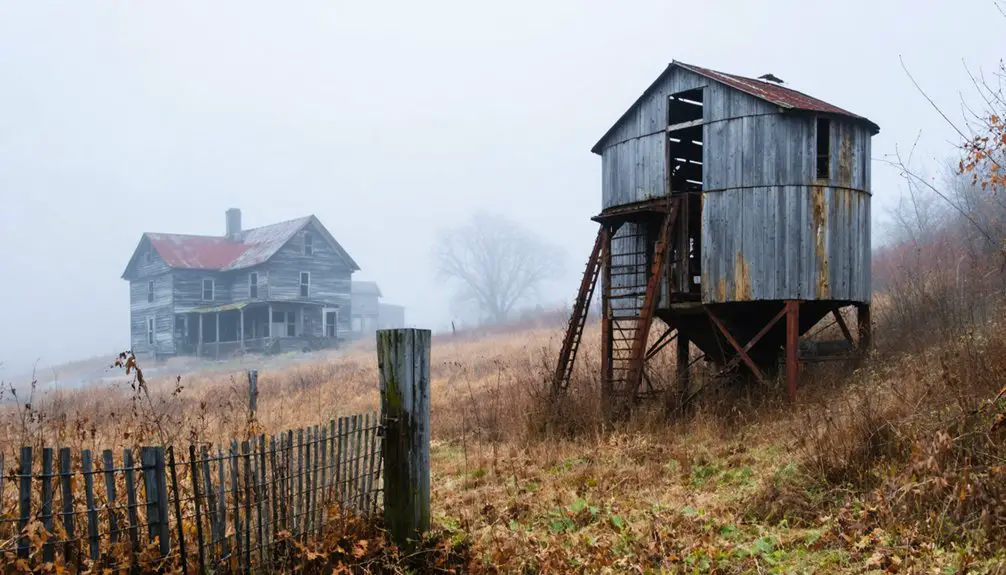
Throughout the Ohio Valley, abandoned settlements tell stories of boom-and-bust cycles that shaped the region’s development.
You’ll find these ghost towns clustered along former railroad corridors and depleted coal mines, with origins tied to the area’s industrial heritage. Places like Moonville and Helltown showcase the economic shifts that led to their abandonment, leaving behind haunting remnants of once-thriving communities.
As you explore these forgotten places, you’ll discover old railroad tunnels, scattered building foundations, and historic cemeteries that paint a picture of small, tight-knit communities.
Many sites have gained new life through preservation efforts, drawing visitors interested in both history and paranormal activity. Local associations work to maintain these cultural landmarks, ensuring their stories aren’t lost to time.
Frequently Asked Questions
Were There Any Notable Crimes or Mysterious Deaths in Rural Hill?
You won’t find documented crimes or mysterious deaths, despite rumors of unsolved mysteries and ghost sightings in the area. The town’s decline came from economic factors, not tragic or criminal events.
Did Native American Settlements Exist in the Area Before Rural Hill?
Like ancient footprints in stone, you’ll find evidence of Native American settlements spanning 11,000 years, with Shawnee, Miami, and Delaware tribes extensively using the land for hunting, fishing, and building earthen mounds.
What Happened to the Cemetery and Burial Grounds After Abandonment?
You’ll find that cemetery preservation efforts often declined after abandonment, with burial practices becoming less documented. Local historical societies sometimes maintained grounds, but many sites suffered from neglect and vandalism over time.
Which Families Were the Last to Leave Rural Hill?
You won’t find specific last residents documented in available records, though family histories suggest the final inhabitants were likely those maintaining local farms or small businesses until economic collapse.
Are There Any Photographs of Rural Hill During Its Peak Years?
You won’t find any verified vintage photographs from Rural Hill’s peak years in historical archives. Despite extensive searches through available records, there’s no documented photographic evidence of the town’s heyday.
References
- https://www.visitbelmontcounty.com/haunted-hills-of-belmont-county/
- https://ohioghosttowns.org/top-10-town-tales/
- https://kids.kiddle.co/List_of_ghost_towns_in_Ohio
- https://wsharing.com/WSphotosGhostTown.htm
- https://ohioghosttowns.org/washington-county/
- https://www.americanhauntingsink.com/helltown
- https://ohioghosttowns.org/top-10-ghost-towns/
- https://en.wikipedia.org/wiki/List_of_ghost_towns_in_Ohio
- https://springhillhistorichome.org/spring-hill-farm/
- https://ruralhill.net/a-brief-history-of-rural-hill/

